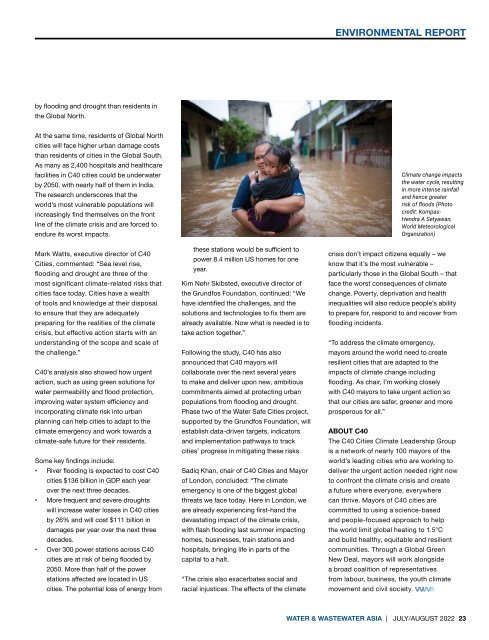Water & Wastewater Asia July/August 2022
Water & Wastewater Asia is an expert source of industry information, cementing its position as an indispensable tool for trade professionals in the water and wastewater industry. As the most reliable publication in the region, industry experts turn this premium journal for credible journalism and exclusive insight provided by fellow industry professionals. Water & Wastewater Asia incorporates the official newsletter of the Singapore Water Association (SWA)
Water & Wastewater Asia is an expert source of industry information, cementing its position as an indispensable tool for trade professionals in the water and wastewater industry. As the most reliable publication in the region, industry experts turn this premium journal for credible journalism and exclusive insight provided by fellow industry professionals. Water & Wastewater Asia incorporates the official newsletter of the Singapore Water Association (SWA)
Create successful ePaper yourself
Turn your PDF publications into a flip-book with our unique Google optimized e-Paper software.
ENVIRONMENTAL REPORT<br />
by flooding and drought than residents in<br />
the Global North.<br />
At the same time, residents of Global North<br />
cities will face higher urban damage costs<br />
than residents of cities in the Global South.<br />
As many as 2,400 hospitals and healthcare<br />
facilities in C40 cities could be underwater<br />
by 2050, with nearly half of them in India.<br />
The research underscores that the<br />
world’s most vulnerable populations will<br />
increasingly find themselves on the front<br />
line of the climate crisis and are forced to<br />
endure its worst impacts.<br />
Mark Watts, executive director of C40<br />
Cities, commented: “Sea level rise,<br />
flooding and drought are three of the<br />
most significant climate-related risks that<br />
cities face today. Cities have a wealth<br />
of tools and knowledge at their disposal<br />
to ensure that they are adequately<br />
preparing for the realities of the climate<br />
crisis, but effective action starts with an<br />
understanding of the scope and scale of<br />
the challenge.”<br />
C40’s analysis also showed how urgent<br />
action, such as using green solutions for<br />
water permeability and flood protection,<br />
improving water system efficiency and<br />
incorporating climate risk into urban<br />
planning can help cities to adapt to the<br />
climate emergency and work towards a<br />
climate-safe future for their residents.<br />
Some key findings include:<br />
• River flooding is expected to cost C40<br />
cities $136 billion in GDP each year<br />
over the next three decades.<br />
• More frequent and severe droughts<br />
will increase water losses in C40 cities<br />
by 26% and will cost $111 billion in<br />
damages per year over the next three<br />
decades.<br />
• Over 300 power stations across C40<br />
cities are at risk of being flooded by<br />
2050. More than half of the power<br />
stations affected are located in US<br />
cities. The potential loss of energy from<br />
these stations would be sufficient to<br />
power 8.4 million US homes for one<br />
year.<br />
Kim Nøhr Skibsted, executive director of<br />
the Grundfos Foundation, continued: “We<br />
have identified the challenges, and the<br />
solutions and technologies to fix them are<br />
already available. Now what is needed is to<br />
take action together.”<br />
Following the study, C40 has also<br />
announced that C40 mayors will<br />
collaborate over the next several years<br />
to make and deliver upon new, ambitious<br />
commitments aimed at protecting urban<br />
populations from flooding and drought.<br />
Phase two of the <strong>Water</strong> Safe Cities project,<br />
supported by the Grundfos Foundation, will<br />
establish data-driven targets, indicators<br />
and implementation pathways to track<br />
cities’ progress in mitigating these risks.<br />
Sadiq Khan, chair of C40 Cities and Mayor<br />
of London, concluded: “The climate<br />
emergency is one of the biggest global<br />
threats we face today. Here in London, we<br />
are already experiencing first-hand the<br />
devastating impact of the climate crisis,<br />
with flash flooding last summer impacting<br />
homes, businesses, train stations and<br />
hospitals, bringing life in parts of the<br />
capital to a halt.<br />
“The crisis also exacerbates social and<br />
racial injustices. The effects of the climate<br />
crisis don’t impact citizens equally – we<br />
know that it’s the most vulnerable –<br />
particularly those in the Global South – that<br />
face the worst consequences of climate<br />
change. Poverty, deprivation and health<br />
inequalities will also reduce people’s ability<br />
to prepare for, respond to and recover from<br />
flooding incidents.<br />
“To address the climate emergency,<br />
mayors around the world need to create<br />
resilient cities that are adapted to the<br />
impacts of climate change including<br />
flooding. As chair, I’m working closely<br />
with C40 mayors to take urgent action so<br />
that our cities are safer, greener and more<br />
prosperous for all.”<br />
ABOUT C40<br />
The C40 Cities Climate Leadership Group<br />
is a network of nearly 100 mayors of the<br />
world’s leading cities who are working to<br />
deliver the urgent action needed right now<br />
to confront the climate crisis and create<br />
a future where everyone, everywhere<br />
can thrive. Mayors of C40 cities are<br />
committed to using a science-based<br />
and people-focused approach to help<br />
the world limit global heating to 1.5°C<br />
and build healthy, equitable and resilient<br />
communities. Through a Global Green<br />
New Deal, mayors will work alongside<br />
a broad coalition of representatives<br />
from labour, business, the youth climate<br />
movement and civil society.<br />
Climate change impacts<br />
the water cycle, resulting<br />
in more intense rainfall<br />
and hence greater<br />
risk of floods (Photo<br />
credit: Kompas-<br />
Hendra A Setyawan,<br />
World Meteorological<br />
Organization)<br />
WATER & WASTEWATER ASIA | JULY/AUGUST <strong>2022</strong> 23


















